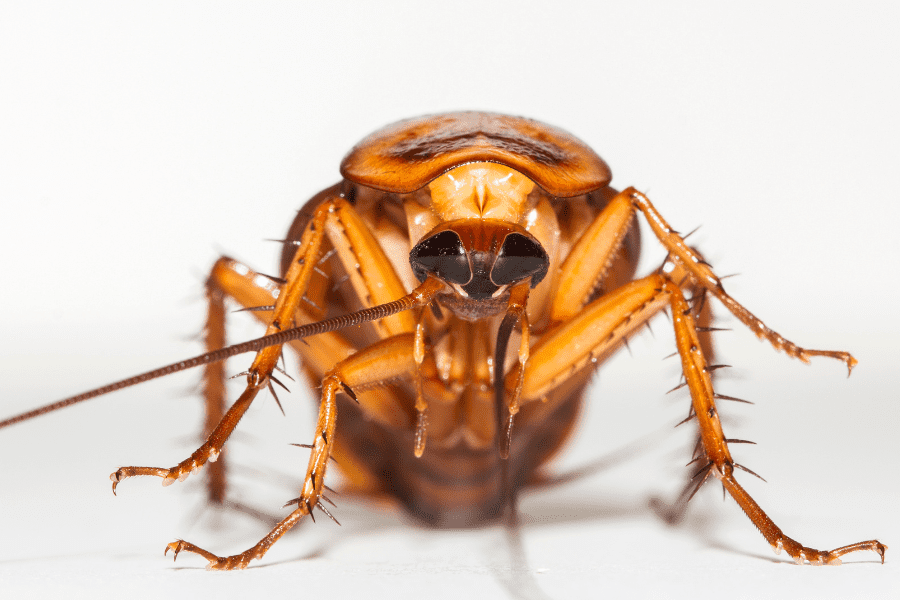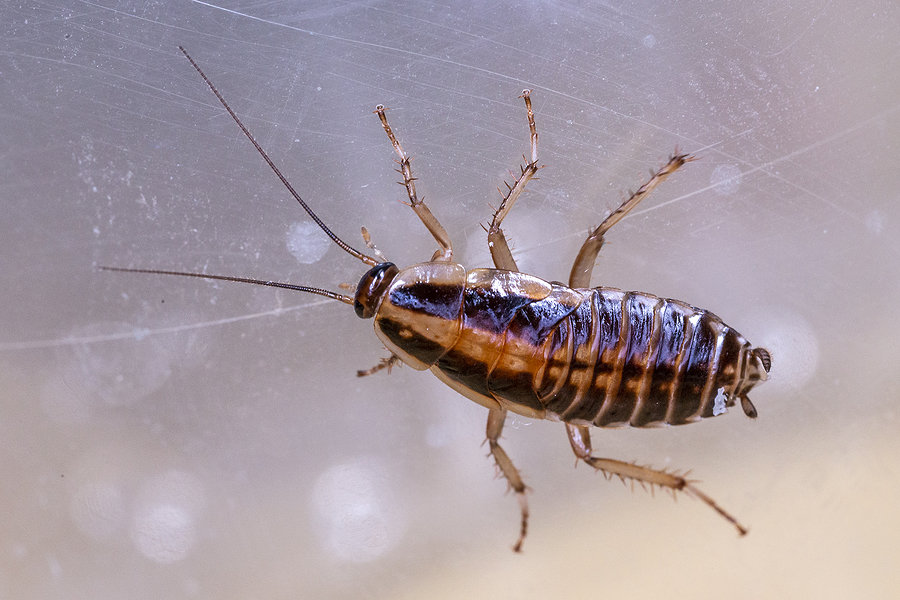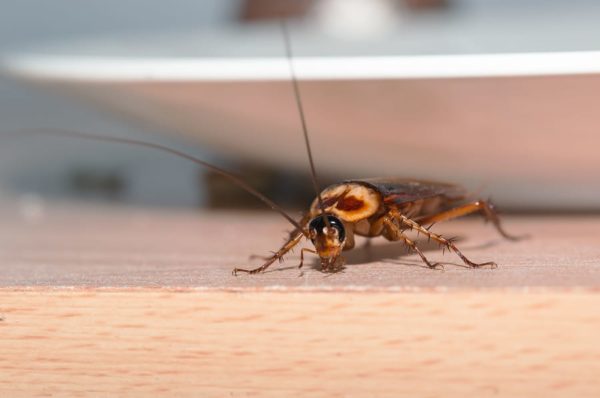READY TO GET STARTED?
REQUEST A FREE ESTIMATE
Fill out the form below or call (888) 466-7849 for a free, no-obligation estimate.

Having an influx of roach activity in your home is never ideal! Cockroaches are year-round pests and are known for their rapid rate of multiplying. The most common roaches found in Augusta homes include the American roach, German roach, and brown-banded roach. Once these roaches have invaded, it can be extremely difficult to get rid of them. Whether you see one roach, multiple roaches, or want to get ahead of the prevention game, consider these cockroach prevention tips below!
To survive, roaches need water and food, typically looking to our homes to search for both. The best way to discourage them from entering is to eliminate their food and water sources. After you’ve cooked or had a meal, it’s important to clean up all the dishes, washing them and putting them away instead of leaving them out at night. Likewise, clean up any leftover spills and crumbs from your meal as soon as possible. Don’t forget to clean your appliances too, as well as wiping down your stovetop, as roaches prefer areas with warmth and the likelihood of spilled food.
Using their small bodies, roaches will enter homes through the smallest gap, hole, or crevice. At least once a year, consider inspecting your windows, doors, foundations, roof, attic vents, crawlspace vents, and even electric, gas, and plumbing lines for points of entry. A good rule of thumb is if you can see daylight shining in, roaches can get inside! Utilize caulk to seal smaller holes and steel wool or foam for larger holes. Consider utilizing a chimney cap and attic vents too.
Moisture provides roaches with a reason to infest, making it essential to eliminate it. These pests only need a small amount to survive. While you’re inspecting for roach entry points, make a note of any leaking faucets, sinks, or pipes and repair them as soon as possible. Likewise, don’t forget to check behind appliances like your refrigerator for excess moisture. Also, consider enclosing your crawlspace to help control moisture underneath your home.
While placing preventative measures around your home can deter roaches away, sometimes it’s best to call a professional for some extra help. If you’ve noticed roaches on your property or are looking to prevent them before they infest, consider contacting your pest control company. These professionals can thoroughly inspect your home, identify the type of cockroach present, identify areas of entry, and provide you with the best treatment and prevention options!

German roaches are the most common species of cockroach worldwide. They can be found infesting just about anywhere that humans occupy. How do you know if you have German cockroaches? What do they look like? Are these roaches dangerous to humans? Get the answers to these questions and more with our 411 on German cockroaches.
German roaches are flat and oval-shaped with 6 legs and a pair of antennae. They are smaller than other species of cockroaches, measuring between 1/2″ and 5/8″ in length. They are light brown to tan in color with 2 dark parallel stripes on their backs, just behind their heads. Females are darker than males. This species has wings but rarely fly; they prefer to run instead.
German cockroaches are an indoor pest, preferring warm, humid environments. They prefer temperatures between 85 and 95 degrees Fahrenheit with 90 to 95% humidity. They make their way indoors by hitchhiking on grocery bags, cardboard boxes, and used appliances. They are often found above refrigerators or other heat producing appliances, under sinks, and around water pipes in kitchens and bathrooms so they can be near food and water sources. They are found throughout the United States.
German roaches will eat almost anything. This includes soap, glue, toothpaste, food crumbs, and bindings of books.
German cockroaches have been linked to disease transmission in humans. As they crawl across fecal matter and other areas, they pick up germs on the spines of their legs and then transfer them to food and other surfaces. It has been proven that German cockroaches spread 33 different bacteria, 6 parasitic worms, and 7 other human pathogens. Their saliva, droppings, and even their dead bodies have proteins that can trigger allergies and increase asthma symptoms, especially in children.
If you spot one German roach in your home, it is highly likely that there are many more hiding in cracks and crevices. Females can lay up to 40 eggs at a time which then mature within about 2 months. The female carries the egg case for up to a month and drops it right before it hatches. They can breed up to 6 generations per year. Adult German roaches can live up to 200 days. This quick reproductive rate combined with their lack of natural predators makes a German cockroach infestation difficult to control.
German cockroaches aggregate in groups when they infest your home. You are likely to find their droppings in areas that they frequent. These droppings appear as small, dark, pepper-like material that is often found on counters and in drawers. Their feces can also stain, leaving dark spots and smears in the corners of rooms, along the tops of doors, and around small cracks and openings in walls. When these roaches infest in large numbers, they can also give off a mild, musty odor.
The first step in preventing a german cockroach infestation is practicing good hygiene. Keep your kitchen and bathroom clean, cleaning up crumbs and spills quickly. Sweep, mop, and vacuum often. Don’t leave any dirty dishes in the sink. Don’t leave pet food and water bowls out overnight. Seal all the openings in the exterior of your home, especially around utility pipes. Ventilate or consider enclosing your crawlspace.
If you suspect you have a cockroach infestation of any species, contact a professional pest control company who can provide you with an in-depth inspection and set you up with an appropriate treatment and prevention plan.
What You Can Expect from Lawn Care Service
What You Need to Know About Millipede Control
Watch out for the Stinging Pests!

Cockroaches have been around for over 300 million years – even longer than the dinosaurs! These pests are resilient and adaptive with odd behaviors and survival tactics which have helped them survive for so long. While most homeowners are aware of the health risks associated with roaches, including allergies, asthma, and the spread of germs and bacteria, there are lots of interesting facts about cockroaches you might not realize. Here are 7 things you might not know about cockroaches.
Cockroaches are one of the most highly adaptable pests on earth which makes them extremely difficult to control or eliminate. To prevent cockroaches keep food sealed and stored properly; clean your kitchen daily; don’t leave food or pet food out overnight; dispose of garbage regularly and use cans with sealing and locking lids; identify any small cracks or holes around your home and seal them; and make sure basements and crawlspaces are kept dry and well ventilated. If you suspect you have a cockroach infestation, contact a professional pest control company who can provide you with a thorough evaluation and appropriate treatment and prevention plan.
How Much Does A Mosquito Treatment Cost?